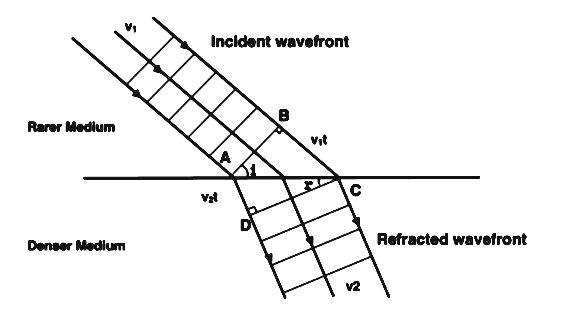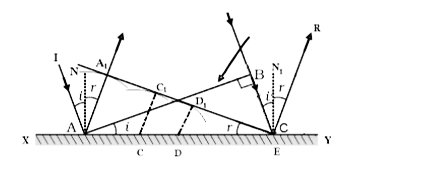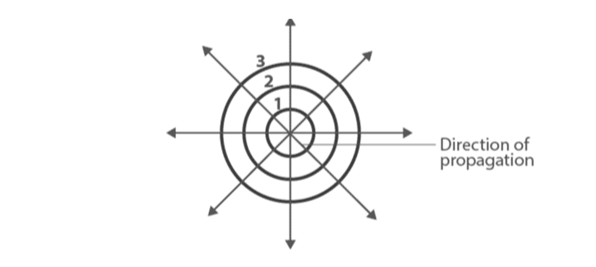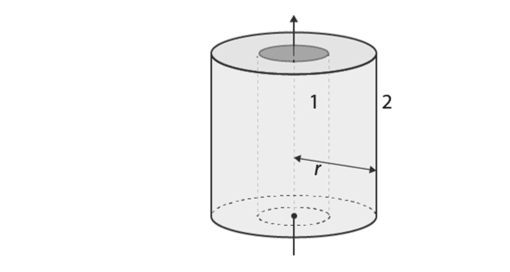Introduction
The link between waves and light rays is the subject of wave optics, also known as physical optics. When the wave qualities of light are taken into account, it is utilized. It is concerned with the study of diverse phenomena such as polarization, diffraction, interference, and other occurrences when geometric optics cannot be represented by rays.
The branch of optics that deals with the behavior of light and its wave characteristics is known as wave optics. When studying and analyzing waves, Huygens principle is one of the most significant principles to remember. Huygens concept essentially aids us in comprehending and describing wave motion.
Body
Wave Optics Theories
According to Sir Isaac Newton’s corpuscular theory, “Light is made up of incredibly small tiny particles called corpuscles that travel at extremely high speeds from the source of light to create a visual sensation by reflecting on the retina of the eyes.”The main flaw in Newton’s corpuscular theory was that it failed to explain why the velocity of light in denser media was lower than in vacuum.
Until Christopher Huygens introduced his wave theory of light in the early 18th century, no one dared to dispute Newton’s corpuscular hypothesis. Light, according to Huygens hypothesis, light is made up of waves that travel through a dilute and highly elastic medium that exists everywhere in space.” This medium is ether.
Huygens Wave Theory
Huygen proposed the wave theory. He claimed that light travels in the form of waves. His theory states that “Every point on a wavefront is in itself the source of spherical wavelets, which spread out in the forward direction at the speed of light. The sum of these spherical wavelets forms the wavefront.”
In the same medium, these secondary wavelets propagate at the speed of light. A wavefront is a real or imaginary surface on which the oscillation phase is constant.
This explanation however, does not explain why refraction happened in the first place.
Second, it couldn’t tell us how light transfers energy along its path.
Secondary Wavelet Principle of Huygens – Statement
Huygens principle, commonly known as the Huygens–Fresnel principle, asserts that each point on a wavefront will generate secondary wavelets or disturbances. Furthermore, disturbances caused by the secondary source spread in all directions the same way as those caused by the primary source do. The principle also says that
- Secondary sources begin to produce their own wavelets, which are identical to those produced by the primary source.
- At any given time, the common tangent on the wavelets in the forward direction produces a new wavefront.
- The wavefront is formed by the sum of spherical wavelets.
Refraction of the plane wave using Huygens Principle
Consider a plane wavefront AB that is incident on the surface, as indicated in the diagram below. Let v1 and v2 be the incident and refracted ray velocities of medium 1 and 2, respectively (v1>v2). The waves’ velocity is determined by the medium. The source of secondary spherical wavelets comes from Huygens principle A and C. Let t be the time it takes to get from B to C.
As a result, BC = v1t in medium 1
Draw a sphere of radius v2t from point A in the second medium to calculate the shape of the refracted wavefront. At time t, it represents the secondary spherical wavefront.
In medium 2, AD = v2t.
The tangent formed from point C to the sphere is now CD. The refracted wavefronts are thus AD and CD.

Refraction laws based on Huygens principle
Now consider ΔABC and ΔADC
Sini / Sinr = (BC/AC) / (AD/AC)
= BC/AD
= v1t/v2t
= v1/v2
= µ (refractive index of the medium)
As a result, Huygens principle is used to prove Snell’s Law of Refraction. The incident wavefront, refracted wavefront, and normal wavefronts are all on the same plane.
Reflection of light using Huygens Principle
Take a look at the plane wave AB that hits the reflecting surface. The incident wavefront is represented by AB, which is drawn perpendicular to the incident ray. On the surface, it falls at an angle of i. Every point on AB now acts as a source of secondary wavelets, according to Huygens principle. Consider points A and B to be fresh sources of secondary waves.
The velocity of wave propagation is denoted by the letter ‘v.’ Let’s say ‘t’ is the amount of time it takes. Assume that vt is the distance that the secondary wavelets have traveled. The secondary waves are AA1 and BE. The new wavefront should now be a tangent line connecting the two secondary waves. The reflected waves should face the new wavefront perpendicularly. The new tangential line connecting the secondary wavelets is A1E.

Reflection laws based on Huygens principle
Consider ΔABE and ΔAA1E. Here AE is common.
<B = <A1 = 90° .
AA1 = BE.
These are congruent triangles,
So <i = <r.
This is the first law of reflection.
The incident wavefront, reflected wavefront, and normal wavefront, all lie parallel to the reflecting surface in the same plane. This proves the second law of reflection once more. As a result, Huygens’ Principle verified the two Laws of Reflection.
Wavefront
The location of all points of the medium that vibrate in the same phase, is characterized as a wavefront.
- The shape of the wavefront is determined by the shape of the disturbance source.
- A wavefront is always normal to the light rays, and it never propagates backwards.
Wavefronts can be one of three sorts, depending on the shape of the light source.
Spherical Wavefront :– The wavefronts of light that emerge from a point source, are spherical in shape.

Cylindrical wavefront
The wavefronts are cylindrical in shape when the light source is linear. The source is equidistant from all of the places.

Plane Wavefront
The wavefronts of light originating from a very far-away source are flat. Because the amplitude of a plane wavefront remains constant, the intensity of the wavefront stays unchanged.
Three types of wavefronts have different aptitudes and intensities.
|
Wavefront types |
Amplitude |
Intensity |
|
Spherical wavefront |
A ∝ 1/r |
I ∝ 1/r2 |
|
Planar wavefront |
A ∝ r0 |
I ∝ r0 |
|
Cylindrical wavefront |
A ∝ 1/√r |
I ∝ 1/r |
Conclusion
According to the Huygens Principle, every point on a wavefront is a generator of wavelets. At the same rate as the source wave, these wavelets expand out in a forward direction. The new wavefront is a straight line that runs parallel to all of the wavelets. A wavefront is a surface on which the phase of an optical wave remains constant.
The principal’s results include:
- The Huygens wave theory that established the concept of light reflection.
- The idea also endorsed the concept of light refraction.
- It proved both the concept of light interference and the concept of light diffraction.
 Profile
Profile Settings
Settings Refer your friends
Refer your friends Sign out
Sign out






